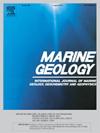Rapid, complex back barrier pedestal formation preconditions washover deposition on the southeast Indian coast
IF 2.6
3区 地球科学
Q2 GEOSCIENCES, MULTIDISCIPLINARY
引用次数: 0
Abstract
Washover deposits formed by overwash are important deposits for evaluating the stratigraphy and evolution of coastal environments. Examination of preserved washover fans can provide a palaeotempestological record that inform past and recent coastal risk with a view to predicting future coastal risk. The recognition of past washover deposits in coastal systems requires detailed knowledge of the internal structure of recent deposits including washover fans. We used very high frequency Ground Penetrating Radar and satellite imagery to examine the internal architecture of the 31st December 2011 Cyclone Thane surge-generated washover deposit on the beach that blocked the Thenpennai River at Thazhamkuda, near Cuddalore in Tamil Nadu Province, southeastern India. Cyclone Thane overwash overtopped the beach and deposited sediments on the contemporary beach and behind the beach within the former channel of the blocked river. The modern washover fan thus contains sediments that are preserved subaqueously and subaerially. We demonstrate that the internal architecture of the fan at Thazhamkuda is largely controlled by the pre-existing topography, and erosional and depositional processes as the cyclone washed sediment inland. At the landward margin of the fan, terminal foreset bedding is preserved and is likely to be one of the only features that can discriminate storm over tsunami deposits.
求助全文
约1分钟内获得全文
求助全文
来源期刊

Marine Geology
地学-地球科学综合
CiteScore
6.10
自引率
6.90%
发文量
175
审稿时长
21.9 weeks
期刊介绍:
Marine Geology is the premier international journal on marine geological processes in the broadest sense. We seek papers that are comprehensive, interdisciplinary and synthetic that will be lasting contributions to the field. Although most papers are based on regional studies, they must demonstrate new findings of international significance. We accept papers on subjects as diverse as seafloor hydrothermal systems, beach dynamics, early diagenesis, microbiological studies in sediments, palaeoclimate studies and geophysical studies of the seabed. We encourage papers that address emerging new fields, for example the influence of anthropogenic processes on coastal/marine geology and coastal/marine geoarchaeology. We insist that the papers are concerned with the marine realm and that they deal with geology: with rocks, sediments, and physical and chemical processes affecting them. Papers should address scientific hypotheses: highly descriptive data compilations or papers that deal only with marine management and risk assessment should be submitted to other journals. Papers on laboratory or modelling studies must demonstrate direct relevance to marine processes or deposits. The primary criteria for acceptance of papers is that the science is of high quality, novel, significant, and of broad international interest.
 求助内容:
求助内容: 应助结果提醒方式:
应助结果提醒方式:


